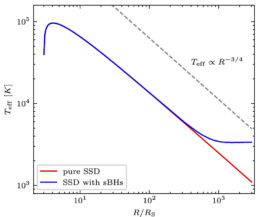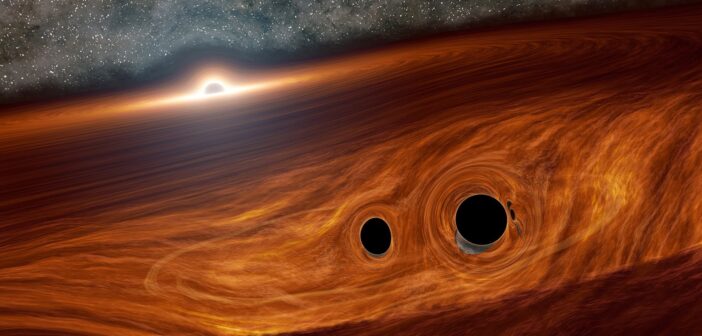Researchers estimate that the accretion disks of supermassive black holes could host millions of stars. When these stars evolve into black holes, they may reshape the observational properties of the disks they call home.
Stellar Extremophiles
Countless stars across the universe have taken up residence in the vicinity of supermassive black holes, including in the dusty disks that surround black holes that are actively accreting gas, otherwise known as active galactic nuclei. Some stars are born in these black hole disks, condensing out of the dusty gas on the outskirts of the disk, where the gas is cooler and feels less of the black hole’s tidal pull. Others may be trapped there, the friction of passing through the disk eventually wearing their orbits down until the stars settle within the disk.
Whether born there or captured, many of these stars will evolve into stellar-mass black holes. Researchers estimate that in the 10–100-million-year lifetime of an active galactic nucleus, its disk may host anywhere from 100 to 100 million stellar-mass black holes. How can we tell if a supermassive black hole’s accretion disk is home to stellar-mass black holes?
Heating Up the Outskirts

Modeled temperature of an accretion disk with (blue line) and without (red line) embedded stellar-mass black holes. [Adapted from Zhou et al. 2024]
As stellar-mass black holes orbit within the supermassive black hole’s accretion disk, they accrete some of the gas. This accreted gas becomes extremely hot and emits X-rays that warm the gas that’s nearby. In the outskirts of the disk, where the temperature is lower, this process can heat the disk a potentially measurable amount.

Comparison of the model output for a static standard disk (SSD) and a disk in which stellar-mass black holes are embedded (SSD with sBHs) and a composite active galactic nucleus spectrum. Click to enlarge. [Zhou et al. 2024]
Spotting Black Holes in Black Hole Disks
Zhou’s team compared the spectral energy distributions — how energy output is distributed across different wavelengths of light — for accretion disks that host stellar-mass black holes and those that do not. For a supermassive black hole with a mass of 100 million solar masses, the presence of stellar-mass black holes in the accretion disk greatly boosts the disk’s energy output at wavelengths greater than 470 nanometers (nm) and slightly suppresses the disk’s energy output at shorter wavelengths. For more massive black holes, the energy-boosting effect happens at longer wavelengths, above about 800 nm.
In addition to altering the spectral energy distribution, the presence of stellar-mass black holes may also increase the accretion disk’s half-light radius, or the radius within which half of the disk’s light is emitted. This change is potentially measurable through microlensing of active galactic nuclei by foreground galaxies. In fact, it may have already been measured — some microlensing measurements suggest that the half-light radii of distant active galactic nuclei are 2–4 times larger than expected for a typical accretion disk.
Citation
“Stellar Black Holes Can ‘Stretch’ Supermassive Black Hole Accretion Disks,” Shuying Zhou et al 2024 ApJL 966 L9. doi:10.3847/2041-8213/ad3c3f

